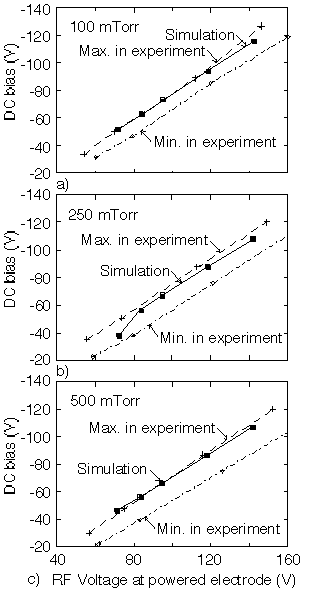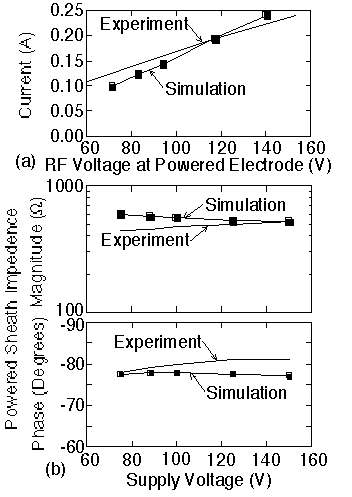

NONLINEAR INTERACTION OF PLASMAS AND CIRCUIT*
Shahid Rauf and
Mark J. Kushner
Department of Electrical & Computer Engineering
University of Illinois at Urbana-Champaign
1406 W. Green St., Urbana, IL 61801
1. Introduction
Since radio frequency (rf) powered plasmas are generally nonlinear, their interaction with the circuitry of plasma processing reactors is not an easily predictable relationship. Past experiments have, for example, demonstrated that the use of different circuit components, which nevertheless have equivalent characteristics at the fundamental frequency, can produce quite varied plasma and electrical properties. Seemingly small variances in external circuit parameters, such as changing the cable length between the matchbox and the reactor, have also been found to strongly influence plasma characteristics. With the advent of real time control strategies for plasma processing reactors which employ first principles models to determine actuator settings, such as electrode voltage, accurate representations of the nonlinear coupling between circuit parameters and plasma characteristics are required. To address these needs, and to more generally investigate the nonlinear relationship between circuitry and plasma properties in asymmetric rf discharges, a coupled circuit and 2-dimensional plasma equipment model has been developed.
2. Computational Model
Since straight-forward simultaneous simulation of the plasma and external circuitry is often impractical because of the large disparity in plasma and circuit time scales, our approach iteratively links the a plasma equipment model and a circuit model. In this approach, we periodically construct a simple circuit representation of the plasma reactor using intermediate results during the plasma equipment simulation. The circuit model consists of a set of interconnected sheaths and resistors which are connected to the external circuitry. The resulting nonlinear circuit is simulated until steady-state conditions are obtained. The results from the steady-state circuit model are then used to update voltages (dc, fundamental and harmonics) at the reactor electrodes, which act as boundary conditions for solution of Poisson's equation in the plasma equipment model. This procedure is iterated until both plasma and external circuit parameters attain steady-state conditions. We have used the Hybrid Plasma Equipment Model (HPEM) for reactor modeling.
3. Results
Our studies, so far, have focused on the capacitively coupled GEC reference cell for which extensive experimental data is available. We investigated the effect of gas pressure, applied voltage, electrode spacing, addition of reactive gases and stray coupling on the electrical and plasma characteristics. As shown below, the results and trends, in general, agree well with experiments. Results from this investigation show that nonlinearity of the sheaths leads to currents and voltages which have significant higher harmonic content. As a consequence, plasmas do not interact identically with external circuits that may merely be equivalent at the fundamental frequency. For example, exchanging the matching network with an equivalent one at the fundamental frequency was found to have a noticeable effect on the dc bias and plasma properties. Results from these studies will appear shortly in an upcoming issue of the Journal of Applied Physics.
 |
 |
| Fig. 1: Comparison of computed dc bias with experiment for different pressures and applied voltages. | Fig. 2: Comparison of rf current through the powered electrode sheath and sheath impedance with experiment at 100 mTorr. |
*This work is sponsored by National Institute of Standards and Technology, Defense Advanced Projects Research Agency and Air Force Office of Scientific Research
Last updated: January 21, 1998.